Assessment of Satellite-Derived Precipitation Products for the Beijing Region
Abstract
:1. Introduction
2. Study Area and Data Description
2.1. Study Area
2.2. Datasets
2.2.1. Ground Observations
2.2.2. Satellite-Derived Precipitation Datasets
3. Methods
3.1. Statistical Metrics
3.2. Categorical Metrics
4. Results
4.1. Daily Variation
4.2. Monthly Variation
4.3. Annual Variation
4.4. Precipitation Intensity
5. Discussion
6. Conclusions
Author Contributions
Funding
Acknowledgments
Conflicts of Interest
References
- Hou, A.Y.; Kakar, R.K.; Neeck, S.; Azarbarzin, A.A.; Kummerow, C.D.; Kojima, M.; Oki, R.; Nakamura, K.; Iguchi, T. The global precipitation measurement mission. Bull. Am. Meteorol. Soc. 2013, 95, 701–722. [Google Scholar] [CrossRef]
- Liao, R.W.; Zhang, D.B.; Shen, Y. Validation of six satellite-derived rainfall estimates over China. Meteorol. Mon. 2015, 41, 970–979. (In Chinese) [Google Scholar]
- Liu, Y.B.; Fu, Q.N.; Song, P.; Dou, C.C. Satellite retrieval of precipitation: An overview. Adv. Earth Sci. 2011, 26, 1162–1172. (In Chinese) [Google Scholar]
- IPCC. Climate Change 2013: The Physical Science Basic Contribution of Working Group 7 to the Fifth Assessment Report of the Intergovernmental Panel on Climate Change; Cambridge University Press: Cambridge, UK; New York, NY, USA, 2013. [Google Scholar]
- Zhang, Y.Q.; You, Q.L.; Chen, C.C.; Ge, J. Impacts of climate change on streamflows under RCP scenarios: A case study in Xin River Basin, China. Atmos. Res. 2016, 178–179, 521–534. [Google Scholar] [CrossRef]
- O’Reilly, C.M.; Sharma, S.; Gray, D.K.; Hampton, S.E.; Read, J.S.; Rowley, R.J.; Schneider, P.; Lenters, J.D.; McIntyre, P.B.; Kraemer, B.M.; et al. Rapid and highly variable warming of lake surface waters around the globe. Geophys. Res. Lett. 2015, 42, 10773–10781. [Google Scholar] [CrossRef]
- Wololway, R.I.; Merchant, C.J. Amplified surface temperature response of cold, deep lakes to inter-annual air temperature variability. Sci. Rep. 2017, 7, 4130. [Google Scholar] [CrossRef]
- Sakalli, A. Sea surface temperature change in the Mediterranean Sea under climate change: A linear model for simulation of the sea surface temperature up to 2100. Appl. Ecol. Environ. Res. 2017, 15, 707–716. [Google Scholar] [CrossRef]
- Dore, M.H.I. Climate change and changes in global precipitation patterns: What do we know? Environ. Int. 2005, 31, 1167–1181. [Google Scholar] [CrossRef] [PubMed]
- Jones, P.D.; Hulme, M. Calculation regional climatic time series for temperature and precipitation: Methods and illustrations. Int. J. Climatol. 1996, 16, 361–377. [Google Scholar] [CrossRef]
- Hulme, M.; Osborn, T.J.; Johns, T.C. Precipitation sensitivity to global warming: Comparison of observation with HadCM2 simulations. Geophys. Res. Lett. 1998, 25, 3379–3382. [Google Scholar] [CrossRef]
- Zhang, J.Y.; Wang, Y.T.; He, R.M.; Hu, Q.F.; Song, X.M. Discussion on the urban flood and waterlogging and causes analysis in China. Adv. Water Sci. 2016, 27, 485–491. (In Chinese) [Google Scholar]
- Yuan, Y.; Shi, P.J.; Liu, Y.H.; Zou, M. Impact of land use change on urban flood disaster. J. Nat. Disasters 2003, 12, 6–13. (In Chinese) [Google Scholar]
- Cai, Y.C.; Jin, C.J.; Wang, A.Z.; Guan, D.X.; Wu, J.B.; Yuan, F.H.; Xu, L.L. Comprehensive precipitation evaluation of TRMM 3B42 with dense rain gauge networks in a mid-latitude basin, northeast China. Theor. Appl. Climatol. 2015, 126, 659–671. [Google Scholar] [CrossRef]
- Liu, S.H.; Yan, D.H.; Wang, H.; Li, C.Z.; Qin, T.L.; Weng, B.S.; Xing, Z.Q. Evaluation of TRMM 3B42V7 at the basin scale over mainland China. Adv. Water Sci. 2014, 33, 522–529. (In Chinese) [Google Scholar]
- Tang, G.Q.; Li, Z.; Xue, X.W.; Hu, Q.F.; Yong, B.; Hong, Y. A Study of substitutability of TRMM remote sensing precipitation for gauge-based observation in Ganjiang River Basin. Adv. Water Sci. 2015, 26, 340–346. (In Chinese) [Google Scholar]
- Chen, Y.; Ebert, E.E.; Walsh, K.J.E.; Davidson, N.E. Evaluation of TRMM 3B42 precipitation estimates of tropical cyclone rainfall using PACRAIN data. J. Geophys. Res. Atmos. 2013, 118, 2184–2196. [Google Scholar] [CrossRef] [Green Version]
- Salio, P.; Hobouchian, M.P.; Garacia, S.Y.; Vila, D. Evaluation of high-resolution satellite precipitation estimates over southern South America using a dense rain gauge network. Atmos. Res. 2015, 163, 146–161. [Google Scholar] [CrossRef]
- Seyyedi, H.; Anagnostou, E.N.; Beighley, E.; Mccollum, J. Hydrologic evaluation of satellite and reanalysis precipitation datasets over a mid-latitude basin. Atmos. Res. 2015, 164–165, 37–48. [Google Scholar] [CrossRef]
- Koutsouris, A.J.; Chen, D.; Lyson, S.W. Comparing global precipitation data sets in eastern Africa: A case study of Kilombero Valley, Tanzania. Int. J. Climatol. 2016, 36, 2000–2014. [Google Scholar] [CrossRef]
- Wu, Z.Y.; Xu, Z.G.; Wang, F.; He, H.; Zhou, J.H.; Wu, X.T.; Liu, Z.C. Hydrologic evaluation of multi-source satellite precipitation products for the upper Huaihe River Basin, China. Remote Sens. 2018, 10, 840. [Google Scholar] [CrossRef]
- Dezfooli, D.; Abdollahi, B.; Hosseini-Moghari, S.M.; Ebrahimi, K. A comparison between high-resolution satellite precipitation estimates and gauge measured data: Case study of Gorganrood basin, Iran. J. Water Supply 2018, 67, 236–251. [Google Scholar] [CrossRef]
- Sultana, R.; Nasrollahi, N. Evaluation of remote sensing precipitation estimates over Saudi Arabia. J. Arid Environ. 2018, 151, 90–103. [Google Scholar] [CrossRef]
- Zeng, Q.L.; Wang, Y.Q.; Chen, L.F.; Wang, Z.F.; Zhu, H.; Li, B. Inter-comparison and evaluation of remote sensing precipitation products over China from 2005 to 2013. Remote Sens. 2018, 10, 168. [Google Scholar] [CrossRef]
- Jiang, S.H.; Liu, S.Y.; Ren, L.L.; Yong, B.; Zhang, L.Q.; Wang, M.H.; Lu, Y.J.; He, Y.Q. Hydrologic evaluation of six high resolution satellite precipitation products in capturing extreme precipitation and streamflow over a Medium-sized basin in China. Water 2018, 10, 25. [Google Scholar] [CrossRef]
- Hur, J.; Ranghavan, S.V.; Nguyen, N.S.; Liong, S.Y. Are satellite products good proxies for gauge precipitation over Singapore? Theor. Appl. Climatol. 2018, 132, 921–932. [Google Scholar] [CrossRef]
- Guo, H.; Bao, A.M.; Ndayisaba, F.; Liu, T.; Kurban, A.; De, M.P. Systematical evaluation of satellite precipitation estimates over central Asia using an improved Error-component procedure. J. Geophys. Res. Atmos. 2017, 122, 10906–10927. [Google Scholar] [CrossRef]
- Ning, S.W.; Song, F.; Udmale, P.; Jin, J.L.; Thapa, B.R.; Ishidaira, H. Error analysis and evaluation of the latest GSMap and IMERG precipitation products over Eastern China. Adv. Meteorol. 2017, 2017, 1803492. [Google Scholar] [CrossRef]
- Anjum, M.N.; Ding, Y.J.; Shangguan, D.H.; Ahmad, I.; Ijaz, M.W.; Farid, H.U.; Yagoub, Y.E.; Zaman, M.; Adnan, M. Performance evaluation of latest integrated multi-satellite retrievals for Global precipitation measurement (IMERG) over the northern highlands of Pakistan. Atmos. Res. 2018, 205, 134–146. [Google Scholar] [CrossRef]
- Chen, C.; Chen, Q.W.; Duan, Z.; Zhang, J.Y.; Mo, K.L.; Li, Z.; Tang, G.Q. Multiscale comparative evaluation of the GPM IMERG v5 and TRMM 3B42V7 precipitation products from 2015 to 2017 over a climate transition area of China. Remote Sens. 2018, 10, 944. [Google Scholar] [CrossRef]
- Wang, H.; Luo, J.; Ye, J.Y.; Li, Z.J. Comparative analysis of area rainfall in Huaihe river basin estimated by CMORPH-gauge merged data and observed rain gauge data. J. Hohai Univ. 2014, 42, 189–194. (In Chinese) [Google Scholar]
- Qin, Y.X.; Chen, Z.Q.; Shen, Y.; Zhang, S.P.; Shi, R.H. Evaluation of satellite rainfall estimates over the Chinese Mainland. Remote Sens. 2014, 6, 11649–11672. [Google Scholar] [CrossRef]
- Liu, Z. Comparison of precipitation estimates between version 7 3-hourly Trmm multi-satellite precipitation analysis (TMPA) near-real-time and research products. Atmos. Res. 2015, 153, 119–133. [Google Scholar] [CrossRef]
- Tan, M.L.; Ibrahim, A.L.; Duan, Z.; Cracknell, A.P.; Chaplot, V. Evaluation of six high-resolution satellite and ground-based precipitation products over Malaysia. Remote Sens. 2015, 7, 1504–1528. [Google Scholar] [CrossRef]
- Shen, Y.; Xiong, A.; Wang, Y.; Xie, P. Performance of high-resolution satellite precipitation products over China. J. Geophys. Res. Atmos. 2010, 115, D02114. [Google Scholar] [CrossRef]
- Deng, X.L.; Nie, S.P.; Deng, W.T.; Cao, W.H. Satellite evaluation of the performance of gridded monthly precipitation products from reanalysis data, satellite estimates, and merged analyses over China. Theor. Appl. Climatol. 2018, 132, 621–637. [Google Scholar] [CrossRef]
- Zhang, C.; Chen, X.; Shao, H.; Chen, S.Y.; Liu, T.; Chen, C.B.; Ding, Q.; Du, H.Y. Evaluation and intercomparison of high-resolution satellite precipitation estimates-GPM, TRMM, and CMORPH in the Tianshan Mountain Area. Remote Sens. 2018, 10, 1543. [Google Scholar] [CrossRef]
- Zheng, Z.F.; Wang, Z.W.; Gao, H. Characteristics of extreme precipitation events in summer and its effect on urbanization in Beijing area. Meteorol. Mon. 2013, 39, 1635–1641. (In Chinese) [Google Scholar]
- Song, X.M.; Zhang, J.Y.; Kong, F.Z.; Wang, G.Q.; He, R.M.; Zhu, K. Spatical-temporal variation characteristics of precipitation extremes in Beijing. Adv. Water Sci. 2017, 28, 161–173. (In Chinese) [Google Scholar]
- Bai, L. Study on Near Surface Urban Heat Island Effect of Beijing City Based on Remote Sensing; Nanjing University of Information Science & Technology: Nanjing, China, 2017. (In Chinese) [Google Scholar]
- Song, X.M.; Zhang, J.Y.; Achakouchak, A. Rapid urbanization and changes in trends and spatial-temporal characteristics of precipitation in the Beijing metropolitan area. J. Geophys. Res. Atmos. 2014, 119, 11250–11271. [Google Scholar] [CrossRef]
- Chang, X.D.; Xu, Z.X.; Zhao, G.; Cheng, T.; Song, S.L. Spatial and temporal variations of precipitation during 1979–2015 in Jinan City, China. J. Water Clim. Chang. 2017, 9, 540–554. [Google Scholar] [CrossRef]
- Zhao, J.; Xu, Z.X.; Zuo, D.P. Spatiotemporal variation of potential evapotranspiration in the HeiHe river basin. J. Beijing Norm. Univ. 2013, 4, 164–169. (In Chinese) [Google Scholar]
- Xu, S.G.; Niu, Z.; Shen, Y.; Guang, D. Evaluation and modification of CMORPH multi-satellite precipitation estimates in summer over Tibetan Plateau. Remot Sens. Inf. 2015, 30, 71–76. (In Chinese) [Google Scholar]
- Justine, R.; Melanie, B.; Frederique, S.; Laurent, L. Temporal and spatial assessment of four satellite rainfall estimates over French Guiana and north Brazil. Remote Sens. 2015, 7, 16441–16459. [Google Scholar]
- Su, J.B.; Lv, H.S.; Wang, J.Q.; Ali, M.S.; Zhu, Y.H. Evaluating the applicability of four latest satellite-gauge combined precipitation estimates for extreme precipitation and streamflow predictions over the upper Yellow river basins in China. Remote Sens. 2017, 9, 1176. [Google Scholar] [CrossRef]
- Wei, G.H.; Lv, H.S.; Wade, T.C.; Zhu, Y.H.; Wang, J.Q.; Su, J.B. Evaluation of satellite-based precipitation products from IMERG V04A and V03D, CMORPH and TMPA with gauged rainfall in three climatologic zones. Remote Sens. 2018, 10, 30. [Google Scholar] [CrossRef]
- Huffman, G.J.; Adler, R.F.; Bolvin, D.T.; Gu, G.J.; Nelkin, E.J.; Bowman, K.P.; Hong, Y.; Stocker, E.F.; Wolff, D.B. The TRMM multi-satellite precipitation analysis (TMPA): Quasi-global, multiyear, combined-sensor precipitation estimates at fine scales. J. Hydrometeorol. 2007, 8, 38–55. [Google Scholar] [CrossRef]
- Huffman, G.J. Highlights of version 7 TRMM multi-satellite precipitation analysis (TMPA). In Proceedings of the 5th International Precipitation Working Group Workshop, Hamburg, Germany, 11–15 October 2010; pp. 109–110. [Google Scholar]
- Mantas, V.M.; Liu, Z.; Caro, C.; Pereira, A.J.S.C. Validation of TRMM multi-satellite precipitation analysis (TMPA) products in the Peruvian Andes. Atmos. Res. 2015, 163, 132–145. [Google Scholar] [CrossRef]
- Ren, M.F.; Bo, P.; Xu, Z.X.; Yue, J.J.; Zhang, R. Downscaling of daily extreme temperature in the Yarlung Zangbo River Basin using machine learning techniques. Theor. Appl. Climatol. 2018. [Google Scholar] [CrossRef]
- Chen, A.F.; Chen, D.L.; Molina, C.A. Assessing reliability of precipitation data over the Mekong river basin: A comparison of ground-based, satellite, and reanalysis datasets. Int. J. Climatol. 2018, 38, 4314–4334. [Google Scholar] [CrossRef]
- Prakash, S.; Mitra, A.K.; AghhaKouchhak, A.; Liu, Z.; Norouzi, H.; Pai, D.S. A preliminary assessment of GPM-based multi-satellite precipitation estimates over a monsoon dominated region. J. Hydrol. 2016, 556, 865–876. [Google Scholar] [CrossRef]
- Tang, G.Q.; Ma, Y.Z.; Long, D.; Zhong, L.Z.; Hong, Y. Evaluation of GPM day-1 IMERG and TMPA version-7 legacy products over mainland China at multiple spatiotemporal scales. J. Hydrol. 2016, 533, 152–167. [Google Scholar] [CrossRef]
- Zhai, Y.; Guo, Y.; Zhou, J.; Guo, N.; Wang, J.; Teng, Y. The spatial-temporal variability of annual precipitation and its local impact factors during 1724–2010 in Beijing, China. Hydrol. Process. 2014, 28, 2192–2201. [Google Scholar] [CrossRef]
- Zhang, Y.; Smith, J.A.; Luo, L.F.; Wang, Z.F.; Baeck, M.L. Urbanization and rainfall variability in the Beijing metropolitan region. J. Hydrometeorol. 2013, 15, 2219–2235. [Google Scholar] [CrossRef]
- Yang, F.; Lu, H.; Yang, K.; He, J.; Wang, W.; Wright, J.S.; Li, C.W.; Han, M.L.; Li, Y.S. Evaluation of multiple forcing data sets for precipitation and shortwave radiation over major land areas of China. Hydrol. Earth Syst. Sci. 2017, 21, 5805–5821. [Google Scholar] [CrossRef] [Green Version]
- He, S.W.; Nan, Z.T.; Hou, Y.T. Accuracy evaluation of two precipitation datasets over upper reach of Heihe river basin, northwestern China. Sci. Cold Arid Reg. 2015, 7, 0157–0169. [Google Scholar]
- Kumari, M.; Singh, C.K.; Bakimchandra, O.; Basistha, A. Geographically weighted regression based quantification of rainfall-topography relationship and rainfall gradient in Central Himalayas. Int. J. Climatol. 2017, 37, 1299–1309. [Google Scholar] [CrossRef]
- Hughes, M.; Hall, A.; Fovell, R.G. Blocking in areas of complex topography, and its influence on rainfall distribution. J. Atmos. Sci. 2013, 66, 508–518. [Google Scholar] [CrossRef]
- Ebrahimi, S.; Chen, C.; Chen, Q.W.; Zhang, Y.S.; Ma, N.; Zaman, Q. Effects of temporal scales and space mismatches on the TRMM 3B42 V7 precipitation products in a remote mountainous area. Hydrol. Process. 2017, 31, 4315–4327. [Google Scholar] [CrossRef]
- Easterling, D.R.; Meehl, G.A.; Parmesan, S.A.; Changnon, T.R.K.; Mearns, L.O. Climate extremes: Observations modeling, and impacts. Science 2000, 289, 2068–2074. [Google Scholar] [CrossRef]
- Marosz, M.; Wojcik, R.; Pilarski, M.; Mietus, M. Extreme daily precipitation totals in Poland during summer: The role of regional atmospheric circulation. Clim. Res. 2013, 56, 245–259. [Google Scholar] [CrossRef]



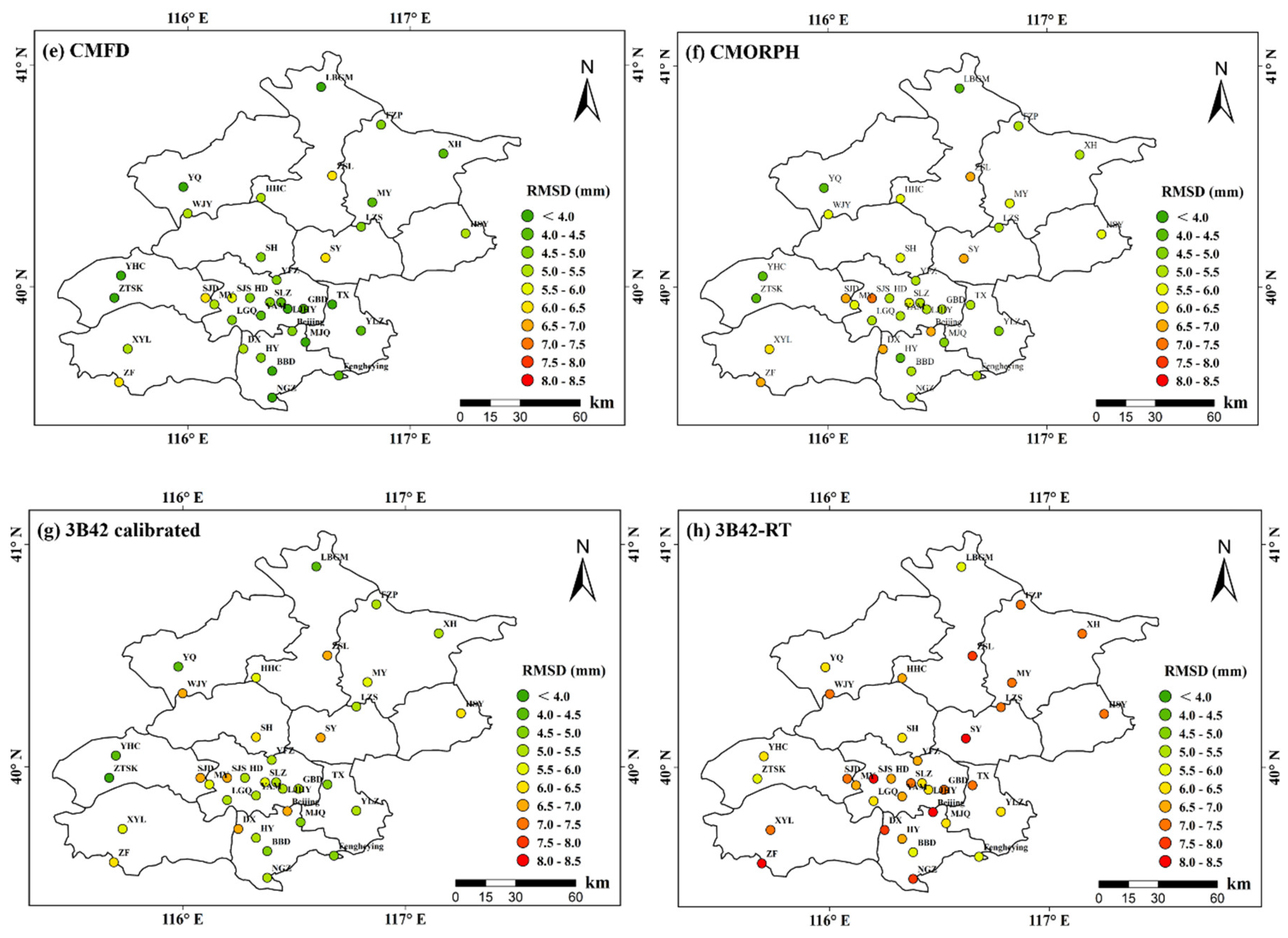

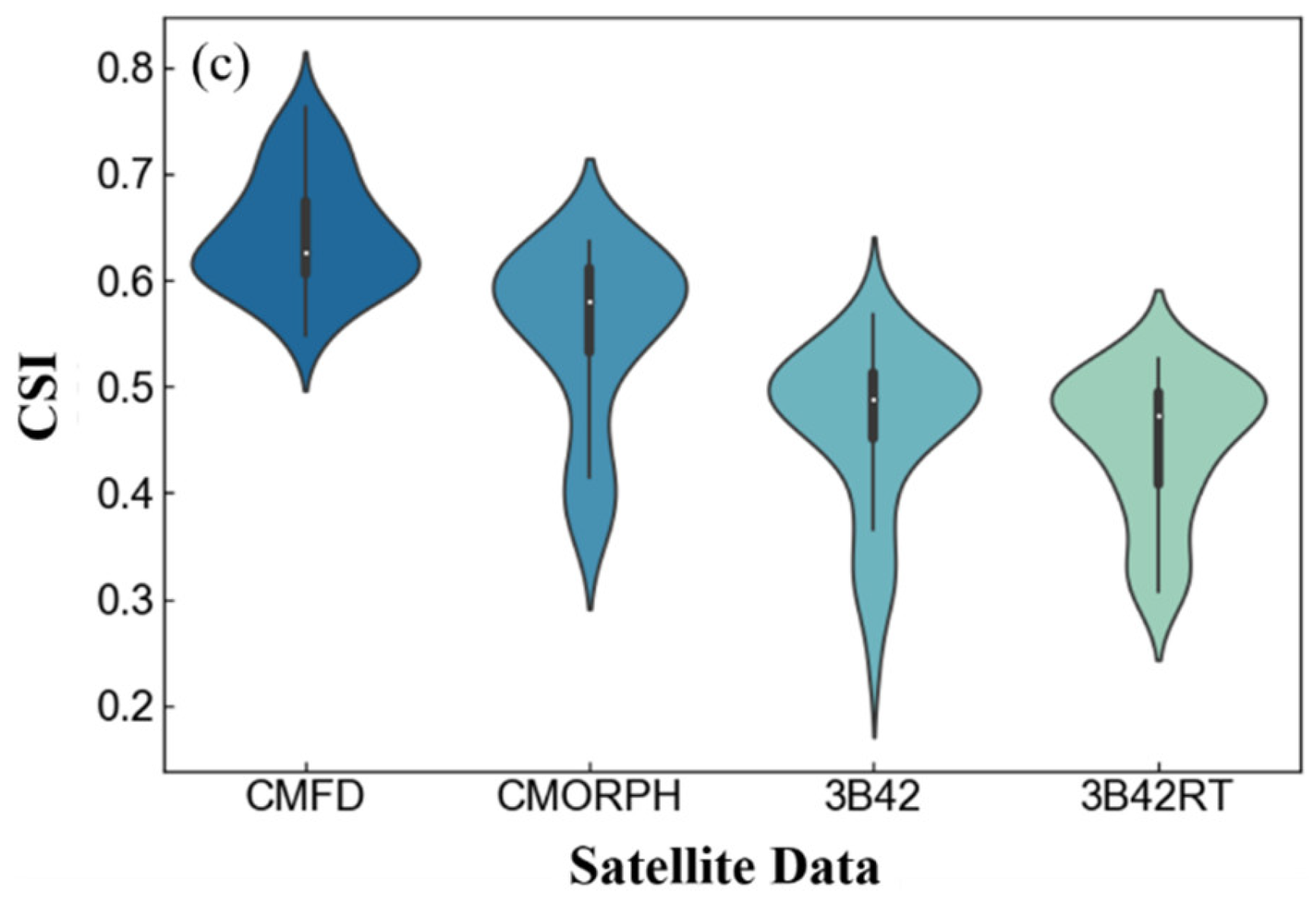
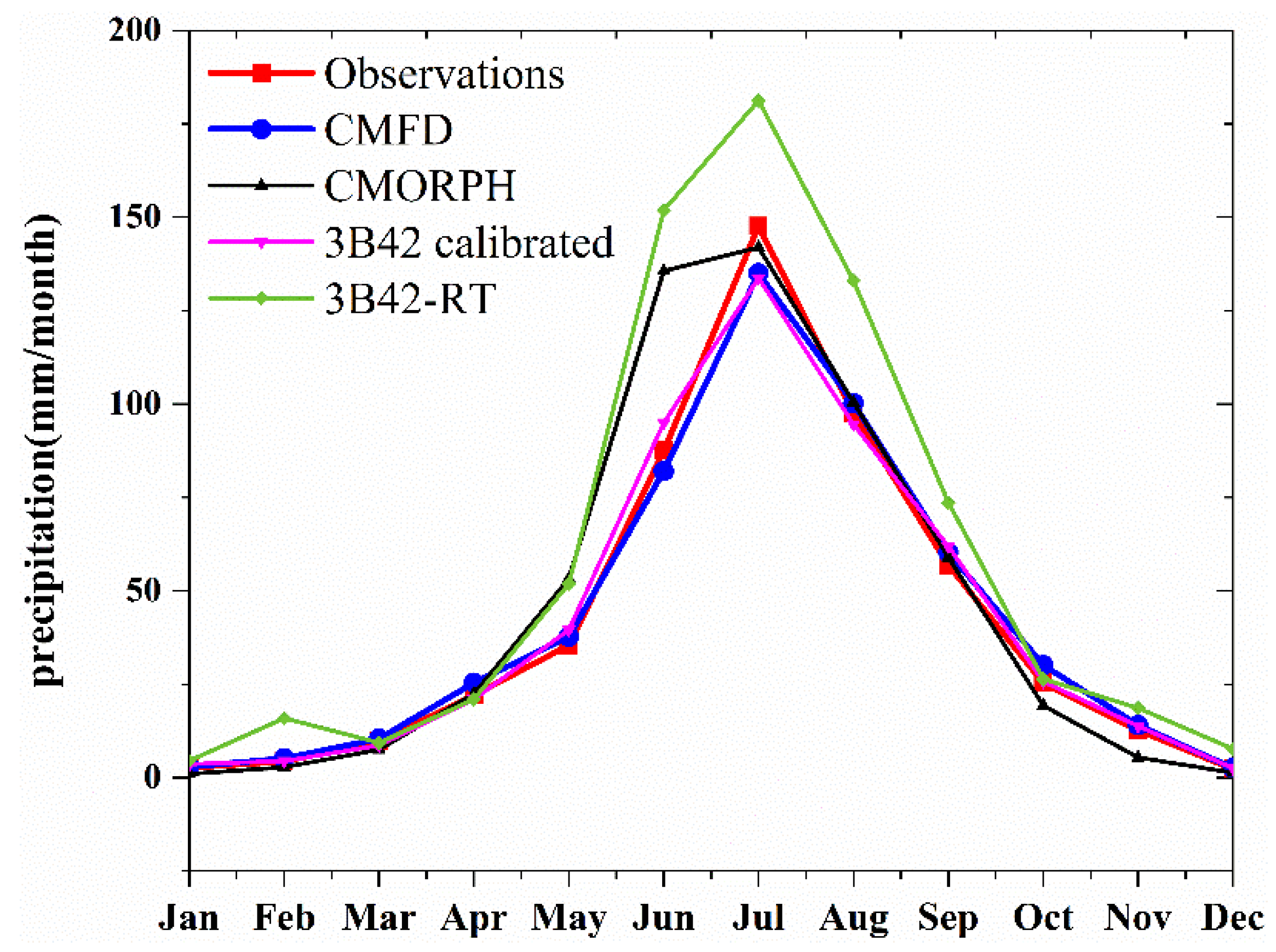
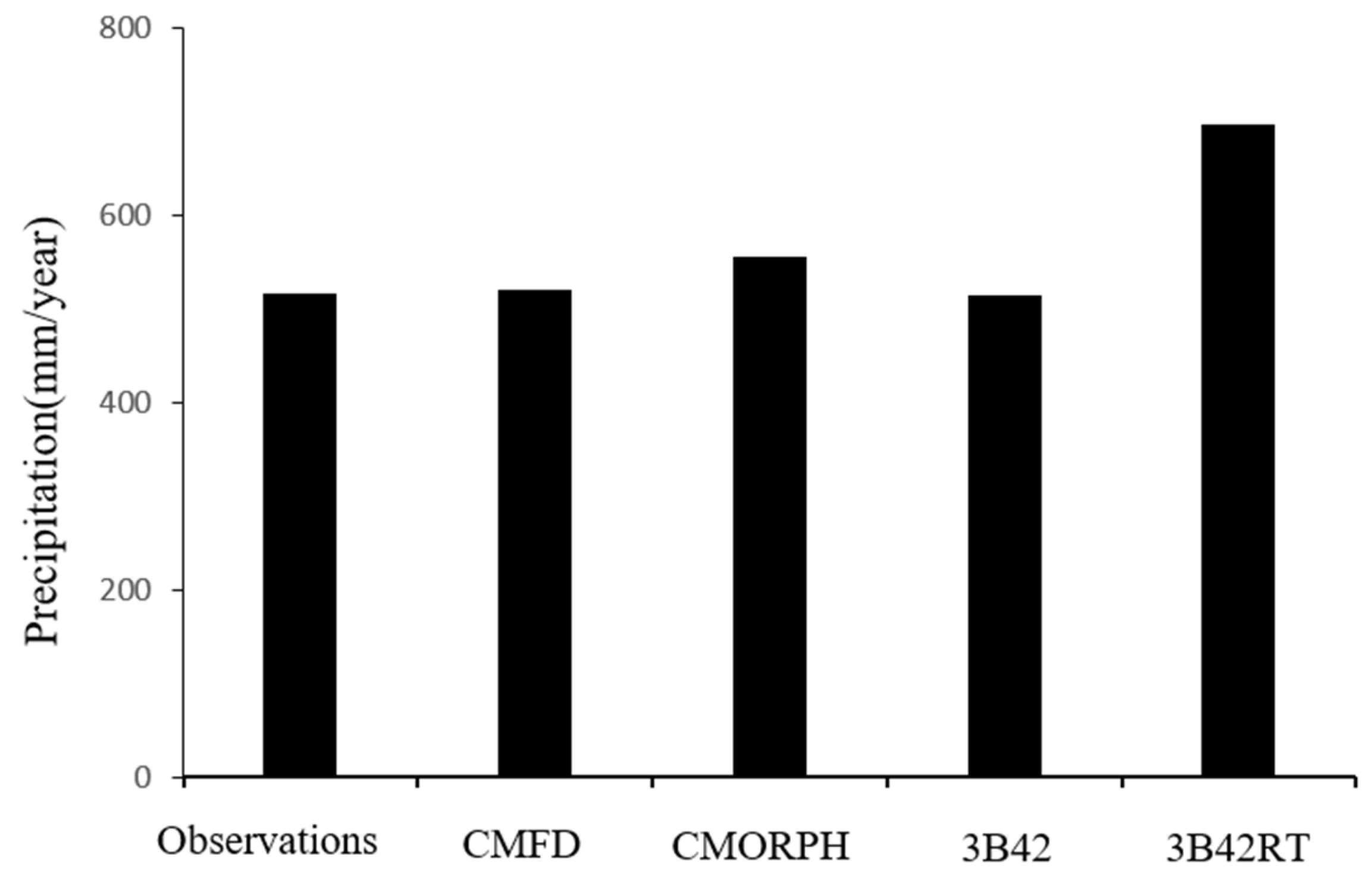

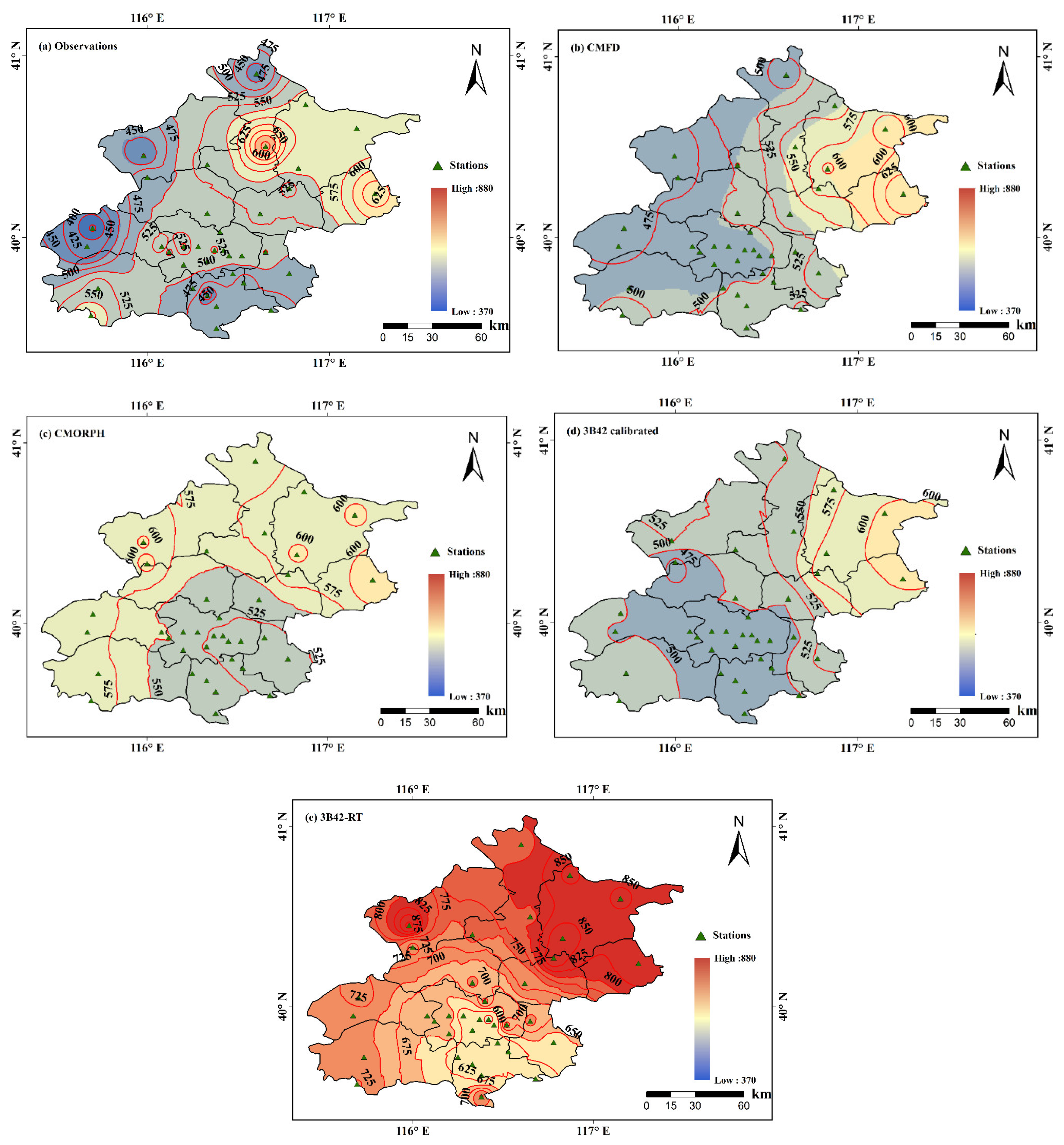
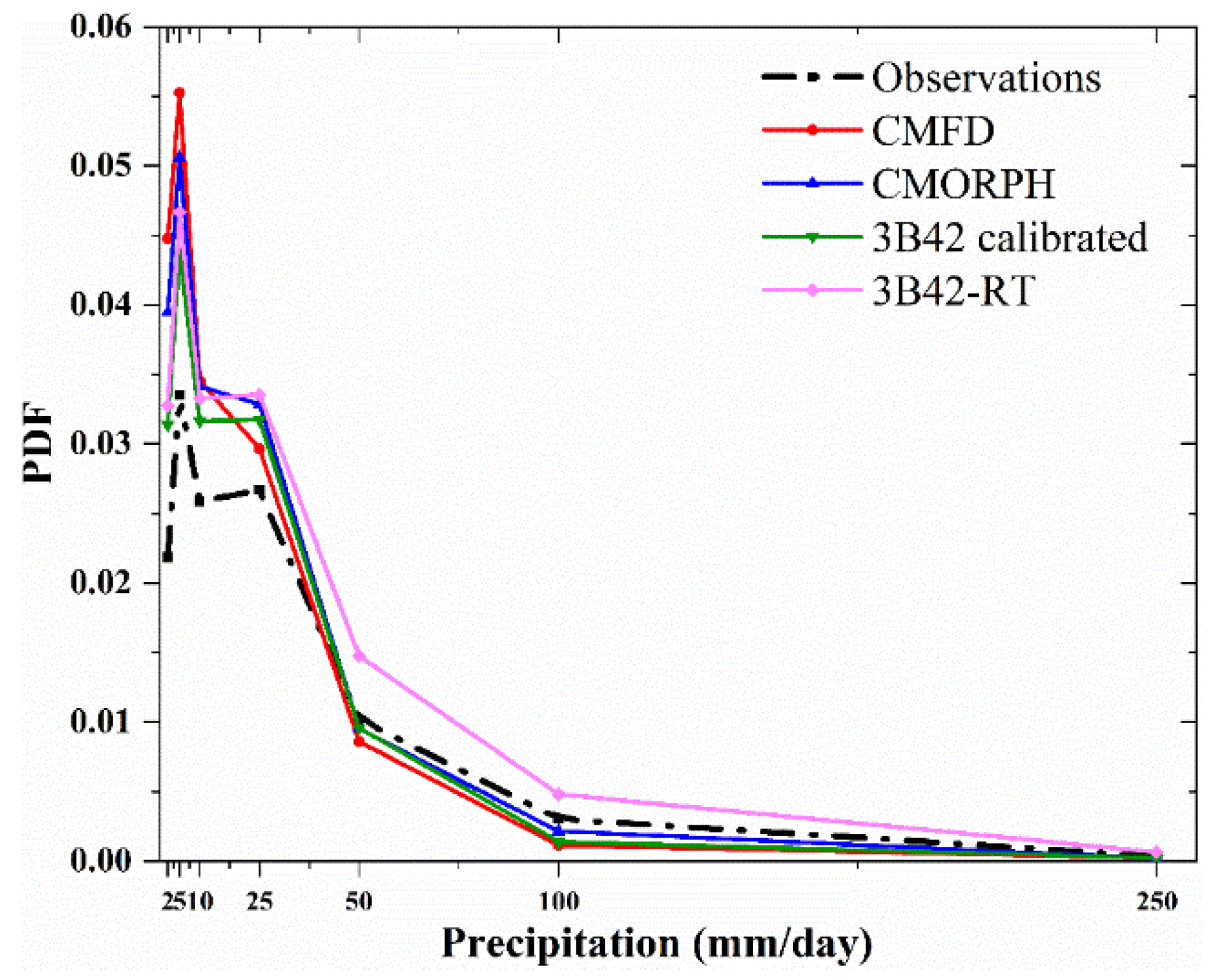

| Station No. | Station Name | Average Annual Precipitation (mm year−1) | Station No. | Station Name | Average Annual Precipitation (mm year−1) |
|---|---|---|---|---|---|
| 1 | Sanjiadian (SJD) | 540.54 | 19 | Songlinzha (SLZ) | 532.19 |
| 2 | Xiahui (XH) | 551.83 | 20 | Zaoshulin (ZSL) | 682.92 |
| 3 | Dongzhimen (DZM) | 510.13 | 21 | Yulinzhuang (YLZ) | 482.00 |
| 4 | Lejiahuayuan (LJHY) | 508.20 | 22 | Shahe (SH) | 510.07 |
| 5 | Fengheying (FHY) | 456.63 | 23 | Yanhecheng (YHC) | 372.06 |
| 6 | Beijing (BJ) | 482.52 | 24 | Haidian (HD) | 499.54 |
| 7 | Qianjiadian (QJD) | 409.75 | 25 | Wangjiayuan (WJY) | 492.69 |
| 8 | Banbidian (BBD) | 472.21 | 26 | Fanzipai (FZP) | 553.21 |
| 9 | Lugouqiao (LGQ) | 512.23 | 27 | Shijingshan (SJS) | 556.73 |
| 10 | Youanmen (YAM) | 502.10 | 28 | Yangfangzha (YFZ) | 507.23 |
| 11 | Tangzhishan (TZS) | 518.33 | 29 | Tongxian (TX) | 525.64 |
| 12 | Labagoumen (LBGM) | 440.44 | 30 | Xiayunling (XYL) | 538.84 |
| 13 | Daxing (DX) | 498.78 | 31 | Shunyi (SY) | 534.76 |
| 14 | Miyun (MY) | 552.46 | 32 | Majuqiao (MJQ) | 451.16 |
| 15 | Yanqing (YQ) | 424.39 | 33 | Gaobeidian (GBD) | 521.06 |
| 16 | Zhangfang (ZF) | 424.39 | 34 | Mayu (MY) | 492.96 |
| 17 | Zhaitangshuiku (ZTSK) | 401.01 | 35 | Huangsongyu (HSY) | 639.42 |
| 18 | Nangezhuang (NGZ) | 472.21 | 36 | Huanghuacheng (HHC) | 531.79 |
| Name | Temporal Resolution | Space Resolution | Type |
|---|---|---|---|
| CMFD | 3 h | 0.1° × 0.1° | Reanalysis |
| CMORPH | daily | 0.25° × 0.25° | Satellite |
| 3B42 | daily | 0.25° × 0.25° | Satellite |
| 3B42-RT | daily | 0.25° × 0.25° | Satellite |
| CMFD | CMORPH | 3B42 | 3B42RT | ||
|---|---|---|---|---|---|
| CC | Average | 0.70 | 0.60 | 0.59 | 0.54 |
| Max | 0.82 | 0.68 | 0.69 | 0.66 | |
| Min | 0.54 | 0.34 | 0.32 | 0.29 | |
| SD | 0.08 | 0.09 | 0.11 | 0.09 | |
| RMSD (mm) | Average | 4.64 | 5.53 | 5.47 | 6.90 |
| Max | 6.21 | 7.45 | 6.92 | 8.38 | |
| Min | 3.31 | 4.18 | 3.92 | 5.84 | |
| SD | 0.84 | 0.82 | 0.82 | 0.70 | |
| MAD (mm) | Average | 1.19 | 1.51 | 1.51 | 1.91 |
| Max | 1.61 | 2.09 | 2.12 | 2.40 | |
| Min | 0.90 | 1.25 | 1.21 | 1.55 | |
| SD | 0.19 | 0.20 | 0.21 | 0.24 | |
| RBS (%) | Average | −2.06 | −10.55 | −1.41 | −38.69 |
| Max | 18.32 | 14.47 | 21.70 | −10.72 | |
| Min | −24.92 | −57.38 | −35.14 | −108.72 | |
| SD | 9.77 | 14.50 | 11.89 | 23.38 |
| POD | FAR | CSI | ||||||||||
|---|---|---|---|---|---|---|---|---|---|---|---|---|
| Average | Max | Min | SD | Average | Max | Min | SD | Average | Max | Min | SD | |
| CMFD | 0.97 | 0.99 | 0.92 | 0.02 | 0.35 | 0.44 | 0.23 | 0.05 | 0.64 | 0.76 | 0.55 | 0.05 |
| CMORPH | 0.87 | 0.94 | 0.69 | 0.07 | 0.40 | 0.56 | 0.31 | 0.08 | 0.55 | 0.64 | 0.37 | 0.08 |
| 3B42 | 0.70 | 0.81 | 0.49 | 0.09 | 0.42 | 0.68 | 0.31 | 0.08 | 0.46 | 0.57 | 0.24 | 0.08 |
| 3B42-RT | 0.71 | 0.85 | 0.49 | 0.10 | 0.45 | 0.64 | 0.36 | 0.07 | 0.45 | 0.53 | 0.31 | 0.07 |
| Precipitation Products | Period | CC | RMSD (mm) | MAD (mm) | RBS (%) |
|---|---|---|---|---|---|
| CMFD | Whole | 0.78 | 17.99 | 13.57 | −10.38 |
| Flood | 0.67 | 38.46 | 29.80 | 0.12 | |
| Non-flood | 0.84 | 7.76 | 5.47 | −15.62 | |
| CMORPH | Whole | 0.32 | 27.78 | 20.68 | 9.21 |
| Flood | 0.49 | 55.36 | 41.61 | −16.30 | |
| Non-flood | 0.23 | 13.99 | 10.22 | 21.98 | |
| 3B42 | Whole | 0.74 | 17.98 | 13.65 | −8.60 |
| Flood | 0.69 | 37.78 | 29.28 | −2.79 | |
| Non-flood | 0.76 | 8.08 | 5.84 | −11.51 | |
| 3B42-RT | Whole | 0.44 | 35.50 | 26.70 | −73.86 |
| Flood | 0.44 | 70.37 | 54.99 | −40.23 | |
| Non-flood | 0.44 | 18.07 | 12.56 | −90.68 |
© 2018 by the authors. Licensee MDPI, Basel, Switzerland. This article is an open access article distributed under the terms and conditions of the Creative Commons Attribution (CC BY) license (http://creativecommons.org/licenses/by/4.0/).
Share and Cite
Ren, M.; Xu, Z.; Pang, B.; Liu, W.; Liu, J.; Du, L.; Wang, R. Assessment of Satellite-Derived Precipitation Products for the Beijing Region. Remote Sens. 2018, 10, 1914. https://doi.org/10.3390/rs10121914
Ren M, Xu Z, Pang B, Liu W, Liu J, Du L, Wang R. Assessment of Satellite-Derived Precipitation Products for the Beijing Region. Remote Sensing. 2018; 10(12):1914. https://doi.org/10.3390/rs10121914
Chicago/Turabian StyleRen, Meifang, Zongxue Xu, Bo Pang, Wenfeng Liu, Jiangtao Liu, Longgang Du, and Rong Wang. 2018. "Assessment of Satellite-Derived Precipitation Products for the Beijing Region" Remote Sensing 10, no. 12: 1914. https://doi.org/10.3390/rs10121914






